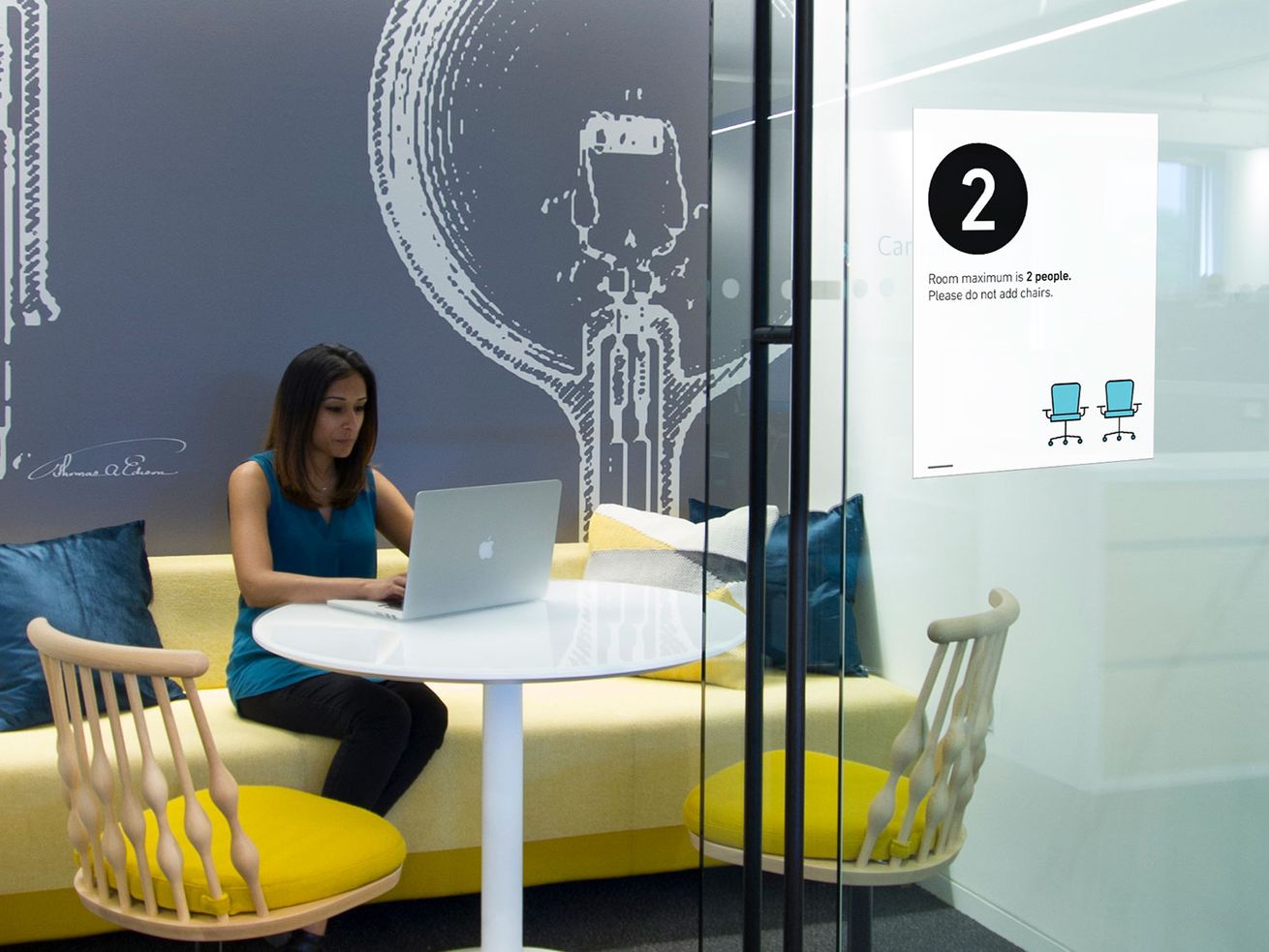An
office conference room displays a sign limiting occupancy to two
people. It’s an example of suggestions the design firm Gensler is
providing to clients. | Provided
Working from home will remain a factor, but those venturing back
to the office in the coming months should expect see a host of new
workplace protocols.
It’s hard these days to even look at an elevator button the
way we used to. Now, we shudder — people touch those things!
Not many are anxious to get back to riding a packed Blue Line L
train to work or even sharing a crowded sidewalk downtown. Standing
in line at a food hall on your lunch break no longer is an
appetizing prospect. Nor is sharing the office kitchen.
For years, the emphasis in office design has been to reduce the
amount of space per employee. The coronavirus pandemic has given
that trend a sharp elbow in the ribs, worse than an office seatmate
with no sense of personal space.
As Chicago and the rest of the nation move toward slowly
reopening the economy, one key question is: What will our
workplaces and work routines will look like in the wake of
COVID-19?
For many — the front-line workers who have borne the brunt of
risk and hardship during the pandemic — little will change. Then,
there’s the rest of, those fortunate enough to be able to work
and shelter in place, whose change in habits has given a thriving,
energetic business core an apocalyptic look.
Nelson Algren’s “City on the Make” has morphed into the
City in a Mask — and in a daze. How quickly we snap out of all of
this will depend on the progress made in fighting the pandemic and
in finding and delivering a vaccine.
One thing that seems certain: The work-from-home phenomenon, now
so popular that “WFH” is part of our messaging shorthand, will
endure, experts on workplace trends say.
“I wish I knew what a recovery will look like, but I don’t
think anybody really does,” said Chicago architect James
Goettsch, chairman of Goettsch Partners. “If we start to see
spikes in infections later this year, it will make people more
conservative. It will be a slow recovery regardless. We’re still
kind of all in shock.”
That might be the first thing to expect — that an economy that
collapsed in the span of days will take a long time to bounce back.
The Federal Reserve and the Congressional Budget Office, pillars of
caution, say an economic recovery might not come until well into
next year. Many economists are more pessimistic.
What else is ahead? When people get back to the office,
they’re going to notice changes, mostly those that are easiest to
make. Masks could be required gear, made available to those who
lack them. Deep-cleaning crews will be purposely visible. And there
will be signs and floor markers attesting to the need for social
distancing. Fussier places might designate one-way pathways.
Sheryl Schulze, a principal in the architecture and design firm
Gensler, said companies are taking some chairs out of conference
rooms and thinning out workstations, perhaps removing every other
chair.
There is less clarity over temperature checks. Do you do it for
everybody or just for visitors? Who is responsible — the tenant
or the landlord — especially if something goes wrong?
Then, there are the dreaded elevators. For buildings that can
afford it, some are trying a “destination dispatch” system that
summons one whenever you scan your way in, perhaps using your
smartphone. The elevator knows your floor and takes you there, no
buttons needed. Some buildings might enforce a limit of four or
even two people to an elevator.
/cdn.vox-cdn.com/uploads/chorus_asset/file/19992947/SterlingBay_333NGreen_NoTouchEntry__1_.jpg) Provided
Provided
Workers demonstrate a no-touch “destination dispatch” system
that Sterling Bay has installed in the office building at 333 N.
Green St. in the West Loop.
Schulze is all too familiar with the potential downside.
“You don’t want your lobbies to look like the TSA lines at
the airport” in prepandemic normalcy, she said.
The phased-in nature of the return to work will help, according
to Schulze.
Many predict that staggered starting times will become
common.
Less apparent to some, especially in the newest offices, will be
ventilation systems that draw in more fresh air and provide greater
filtration, said Patrick Biesty, vice president of engineering for
development firm Sterling Bay.
Goettsch also made that point and foresees the day when
buildings’ air-quality data will be displayed on monitors
alongside the headline news.
Biesty said Sterling Bay installed state-of-the-art ventilation
systems at several properties, including the Midwest headquarters
it built for shipper C.H. Robinson at 1515 W. Webster Ave.
“I don’t think indoor air quality is going away as a concern
anytime soon because it’s tied in to productivity,” he
said.
A larger issue is how many people will be there when offices
start reopening.
“Most clients are not ready to come back yet,” Schulze
said.
Google and Facebook have advised their employees to work from
home if possible through the end of the year. Other employers have
said they’ll look at things after Labor Day. Mark Zuckerberg,
Facebook’s chief executive officer, said he foresees half of his
company working from home permanently within a decade, a
repudiation of the shared-office ethic.
Gensler did a survey of 2,300 U.S. workers that found only 12%
of them want to work from home full-time. The survey found that
people value in-person interactions with colleagues but are hoping
their employers adopt stricter policies against people coming in
when they are sick.
Others have found that work-from-home will remain a part of
office culture. The Chicago consulting firm Grossman Group,
surveying 841 workers across the nation, found that 48% want to
continue working from home in some fashion.
“A great deal has changed in employees’ work lives in a
short time, and if we want them to be engaged and productive,
we’re going to have to be willing to meet them where they are as
much as possible,” said David Grossman, the consulting firm’s
chief executive officer.
He said that while some like working from home, others can’t
wait to get back.
A lot of that has to do with your own circumstances. Do you have
toddlers melting down during your Zoom meetings?
Paul Lundstedt, vice chair of Cushman & Wakefield, said the
real estate firm plans to reopen in 25% stages, allowing people to
work from home if they are uncomfortable coming in.
“A lot of people are very antsy about getting back, especially
people with families,” Lundstedt said.
John Goodman, vice chairman of the office tenant brokerage
Savills, said he sees about 30% of workers staying mostly at home.
Others put the figure at around 50%.
“For many, the work-from-home experiment has worked fine,”
Goodman said. “A lot will say they haven’t lost much
productivity. But senior leadership often has other
concerns.”
Goodman said executives are worried about innovation falling
victim to a lack of in-person collaboration.
What isn’t going to be happening, real estate experts said, is
a wholesale reworking of office layouts, though some brokerages and
consultancies have promoted designs to emphasize less crowding in
the office. Cushman & Wakefield has developed concepts under
the banner of “Six Feet Office” for respecting social
distances.
Most companies are skipping that for now.
“They are staying flexible on working from home,” Goodman
said. “They think this will be solved by [workplace] policy as
opposed to spending a lot of capital on reworking the space.”
Reducing office crowding also flies in the face of trends in
place for the last 30 years. Goettsch noted that offices used to
provide about 250 square feet for each person. That’s been scaled
down to about 110 square feet in layouts for cost-conscious
tenants. Private offices became cubicles which became benches in
some cases.
“Do we need to get out of the trading-desk kind of environment
that the tech world gave us?” Goodman said.
What does that do then to commercial real estate? Does demand
increase because tenants are spreading out? Or do they contract
because of working from home?
“That’s the gazillion-dollar question,” Lundstedt
said.
Experts foresee a gradual decline in demand. Coupled with new
space due to hit the market in the West Loop and Fulton Market, the
demand trend should cause vacancies to rise in the coming
years.
/cdn.vox-cdn.com/uploads/chorus_asset/file/19993358/110_N._Wacker.jpg) Tyler
Tyler
LaRiviere/Sun-Times Construction crews work on a new office
building at 110 N. Wacker Drive. Experts believe that new
construction, coupled with a decline in demand from some tenants,
will create a glut of office space downtown.
There also could be more interest in suburban office sites, even
as satellite locations, for workers who don’t want to visit a
crowded downtown hub all the time. Suburban sites have free
parking, a rare amenity in the city.
But people still have to get to their jobs and confront their
doubts about public transportation.
“Can you imagine what the highway infrastructure is going to
look like? It’s going to be scary,” Lundstedt said.
Erin Aleman, executive director of the publicly funded Chicago
Metropolitan Agency for Planning, has a perspective on the
situation as a policy analyst and as a tenant. Her agency is
relocating its downtown offices into the Old Post Office in the
West Loop. But she said it has no plans to redo the layout yet for
COVID-19 concerns. Work at home will be prominent, but Aleman said
the region still needs to find a way to get people back on public
transit.
The region is interconnected and will still be post-pandemic,
she said. CMAP data show more than half of metro-area workers cross
county lines in their commutes, a proportion that might astound
confirmed city-dwellers who never get beyond Harlem Avenue.
Aleman said the coronavirus will force policymakers to address
issues tied to shared prosperity, such as segregation and income
inequality, overdue repairs of roads and bridges, affordable
housing and broadband access across all communities. It’s a
lengthy agenda and a heavy ask for government funding partners sure
to face extreme pressures of their own.
But Aleman is optimistic.
“I think it’s a generational opportunity to really come out
of this stronger on the other side,” she said.
Using a once-in-a-century infection as a means for improvement
is a bold thought. Are we still up to the task of, to tweak the
words of Chicago visionary Daniel Burnham, making no little
plans?



















